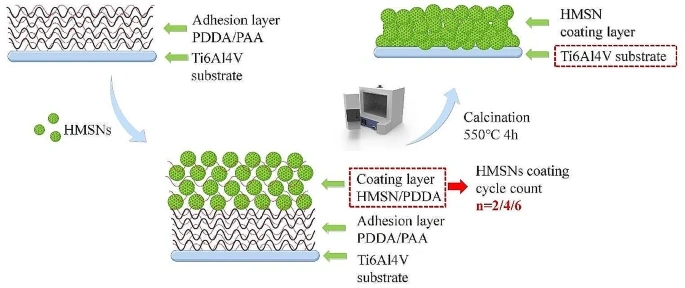Journal of Bionic Engineering (2024) 21:1427–1441https://doi.org/10.1007/s42235-024-00511-9
Bioinspired Hollow Mesoporous Silica Nanoparticles Coating on Titanium Alloy with Hierarchical Structure for Modulating Cellular Functions
Jiaxin Zhang1 · He Liu1 · Jincheng Wang1 · Jing Shang1 · Mingwei Xu1 · Xiujie Zhu1 · Chao Xu2,3 · Haotian Bai1 · Xin Zhao1
1 Orthopedic Institute of Jilin Province, Orthopedic Medical Center, The Second Hospital of Jilin University, Changchun 130041, China
2 Key Laboratory of Bionic Engineering (Ministry of Education), Jilin University, Changchun 130025, China
3 Institute of Structured and Architected Materials, Liaoning Academy of Materials, Shenyang 110167, China
Abstract
3D-printed Porous Titanium Alloy Implants (pTi), owing to their biologically inertness and relatively smooth surface morphology, adversely affect the biological functions of surrounding cells. To address the challenges, constructing a bioinspired interface that mimics the hierarchical structure of bone tissue can enhance the cellular functions of cells. In this context, Hollow Mesoporous Silica Nanoparticles (HMSNs), renowned for their unique physicochemical properties and superior biocompatibility, offer a promising direction for this research. In this research, the initially synthesized HMSNs were used to construct a “hollow-mesoporous-macroporous” hierarchical bioinspired coating on the pTi surface through the Layer-by-Layer technique. Simultaneously, diverse morphologies of coatings were established by adjusting the deposition strategy of PDDA/HMSNs on the pTi surface (pTi-HMSN-2, pTi-HMSN-4, pTi-HMSN-6). A range of techniques were employed to investigate the physicochemical properties and regulation of cellular biological functions of the diverse HMSN coating strategies. Notably, the pTi-HMSN-4 and pTi-HMSN-6 groups exhibited the uniform coatings, leading to a substantial enhancement in surface roughness and hydrophilicity. Meantime, the coating constructed strategy of pTiHMSN-4 possessed commendable stability. Based on the aforementioned ffndings, both pTi-HMSN-4 and pTi-HMSN-6 facilitated the adhesion, spreading, and pseudopodia extension of BMSCs, which led to a notable upsurge in the expression levels of vinculin protein in BMSCs. Comprehensive analysis indicates that the coating, when PDDA/HMSNs are deposited four times, possesses favorable overall performance. The research will provide a solid theoretical basis for the translation of HMSN bioinspired coatings for orthopedic implants.
Keywords Hollow mesoporous silica nanoparticles · Bioinspired coating · Titanium alloy · Hierarchical structure · Cellular functions

Copyright © 2024 International Society of Bionic Engineering All Rights Reserved
吉ICP备11002416号-1









